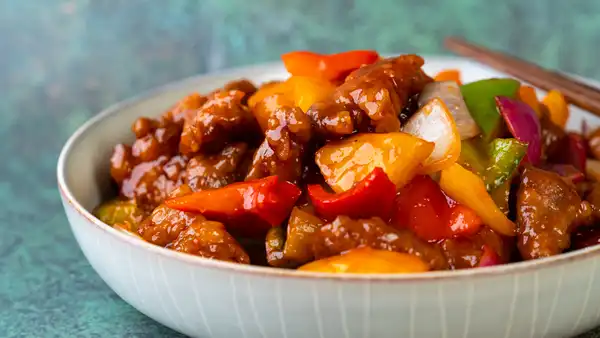By my estimates, my dad has made sweet and sour pork thousands of times over his career. It's practically like breathing for him.
Sweet and sour pork (咕噜肉) sits among some of the most well-known Chinese dishes outside of China. It’s widely believed to be a Cantonese dish, known colloquially as gú lóuh yuhk, which roughly translates to “ancient pork.”
Some tales say the name comes from the “guh guh guh” sound people make as they gulp down the delicious bites of pork.
What's in sweet and sour sauce?
Our recipe calls for ketchup, brown sugar, vinegar, cornstarch, salt, and water. We recommend a homemade sweet and sour sauce instead of using premade packets as it's cheaper, more convenient (most, if not all, of these are pantry staples), more customizable, and probably healthier.
Ketchup in a Chinese dish? Yes!
One of the key ingredients in this sweet and sour pork recipe is ketchup. If you're like me, you might be thinking, “Why is ketchup being used in a traditional Chinese dish?”
So, I went down a rabbit hole and emerged with an appreciation for ketchup and sweet and sour pork as symbols of the many ways in which Eastern and Western cultures have influenced one another. It turns out ketchup has actually been used in quite a lot of traditional Chinese recipes, dating back to the 1900s.
Even though ketchup is now known as a tomato sauce that we throw onto burgers or French fries, we can trace the condiment back to 300 B.C as a Chinese fermented fish sauce.
It feel out of favor unti the 1600s to 1700s when fish sauce was revived in China by traders traveling along the coast between Guangdong and Fujian and Vietnam and Cambodia. In Hokkien, it was called kê-chiap, a name that stuck throughout Southeast Asia.
Around the same era, British traders in Southeast Asia became obsessed with their newly discovered “catchup,” and it quickly took storm as they brought it back to Britain. Initially, British traders made a ton of profit selling imported fish ketchup back at home. Soon after, Westerners started developing their own homegrown recipes for ketchup in order to avoid paying for imported sauce. As ketchup adapted to Western tastes, it gradually morphed into a mushroom-based sauce, then a sweeter tomato-based sauce popularized by companies like Heinz.
As China began importing tomato ketchup in the 1900s, many Chinese chefs started experimenting and incorporating ketchup into traditional sweet and sour dishes as an easier alternative to making the sauce base from scratch. And coming full-circle, as Chinese immigrants made their way to America and other countries, they brought dishes like sweet and sour pork with them.
Great reading:
Check out a quick story summary of our recipe!



